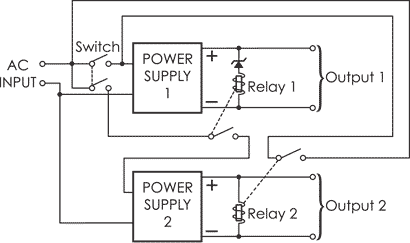Sequencing Power Supplies
Posted by Tom Skopal, Design Engineer
{Entry Date}
In :
Blog Archive
It is certainly not very difficult to have a power supply turn on after another is on - simply connect a relay (‘Relay 1’ in the diagram) across the output of the first, and use it to turn on the second. But that doesn’t address the usual additional requirement for the second power supply’s output to also turn off before the output of the first.
Using another relay (‘Relay 2’ in the diagram) across the output of the second supply and a separate input switch pole (‘Switch’ in the diagram) for each supply meets that requirement. The relay shorts the input switch contacts of the first supply and keeps it on until the output of the second supply has collapsed.

A low voltage relay (‘Relay 1’ in the diagram) in combination with a zener diode to make up the difference between the relay coil rating and the power supply output voltage can be used to delay the turn-on of the second supply until the first is almost up to full voltage. And since a relay typically doesn’t drop out until the voltage is down to 25-35% of its coil rating, the output of the second supply will be almost collapsed before the contacts shorting the input switch pole of the first supply open and it can start to shut down. Alternately, relay modules with trip voltage adjustments may be used.